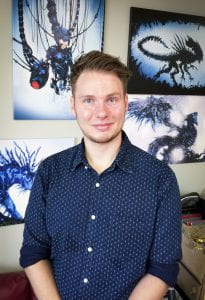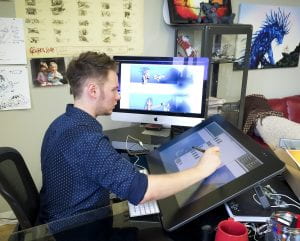Monster muses: Graphic Design grad spins career from childhood passion
 As a kid, Justin Currie used to spend hours drawing dragons, robots and monsters. As an adult, not much has changed – other than now he gets paid for it.
As a kid, Justin Currie used to spend hours drawing dragons, robots and monsters. As an adult, not much has changed – other than now he gets paid for it.
“It’s a much better deal,” says the Red River College alum.
Since graduating from RRC’s Graphic Design – Advanced program in 2007, Currie has managed to transform his childhood passion into a bankable career as an illustrator for his own design studio, Chasing Artwork. The Exchange District company publishes Currie’s own graphic novels – his first one, 2014’s Cassie and Tonk, won the Manuel Dias Manitoba Book Design and Illustration award for 2015 – and originated a unique art technique he calls “shattered vector painting.”
When Currie’s not on the 9-to-5 grind, working on pages and artwork for clients – one of his recent contracts was with Blizzard Entertainment for the popular new Overwatch video game – you can find him possibly anywhere in the world, rubbing elbows with celebrities at comic conventions.
“It’s a lot of fun,” says Currie, fresh from a trip to Megacon in Orlando, Fla., where he moved a pile of copies of Cassie and Tonk.
“I think academically I never really excelled very much, but drawing wise I always seemed to be at the better end of the spectrum, so I just kept that up. Upon graduating from high school, it didn’t look like artwork was going to be much of a career option and then I found out about Graphic Design because a cousin of mine was in the program, and it just really clicked with me — ‘OK, this is what I want to do.’ ”
After being accepted into RRC’s three-year program, he had to face another hurdle: moving to the city.
“It was very eye-opening,” says Currie, who grew up two hours southwest of Winnipeg near Pilot Mound with five siblings and a broken TV.
“I come from a very small town where I was one of the only people doing artwork and then suddenly I was surrounded by all of these other people who had the same passion. Being around like-minded people was a great experience. (There’s a) motivation you get from hanging out with people who are doing something better than you.”
 Friendly competition is common in the design and illustration industry, where you get what you put into your art. “The people who are really succeeding are those annoying people who seem to be nonstop working on new pieces or new projects,” Currie says.
Friendly competition is common in the design and illustration industry, where you get what you put into your art. “The people who are really succeeding are those annoying people who seem to be nonstop working on new pieces or new projects,” Currie says.
Currie does have an edge on a lot of fellow illustrators. He credits his RRC instructors for teaching him how to create vector graphics in Adobe Illustrator. The unique style of design has won over many at the conventions he attends.
“No other artist touches vector unless they’re forced to, and so I’m glad I was forced to until I liked it.”
RRC also gave Currie the backbone of professional design skills that serve him well when dealing with clients. While most people can appreciate an intricate monster sketch, having a successful career as a comic book or video game artist isn’t as simple as putting pencil to paper.
“I think a lot of people don’t realize how prepared this program gets you for the illustration industry,” says Currie. “You need that design background as well. And then you can always fall back onto the design field until you’re ready to make comics or video games full-time.”
Currie plans to spend the next five years expanding Chasing Artwork’s list of published works, and continuing to work the convention circuit, where he’s already secured a few working relationships with celebrities. (He’s not naming names.) Currently, he’s plugging away at two new graphic novels, which he plans to tour.
“Eventually I would like to be able to just release a book and have a built-in audience ready for it without having to travel around,” Currie says. “Then I can just sit back and make books and not have to worry about it. That’s the dream.”
Learn more about RRC’s Graphic Design – Advanced program.
Profile by Lindsey Ward (Creative Communications, 2004)
